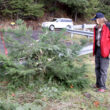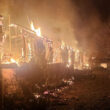Sean C. Morgan
Of The New Era
More than 200 firefighters spent Friday putting out fires off Ames Creek Drive, practicing for the real thing later this summer.
Federal and Oregon agencies combined their fire schools in Sweet Home to provide training for their firefighters in the seventh annual Interagency Fire School.
The intensive training is essential for the safety and effectiveness of the fire crews that battle wildland fires, officials said. Firefighters may be called to travel to other parts of Oregon or other states as well as fighting fires in their home jurisdictions.
Participating agencies included the Oregon Department of Forestry; U.S. Forest Service, Willamette, Siuslaw and Umpqua national forests; the Bureau of Land Management, Eugene and Salem districts; U.S. Fish and Wildlife Department; and the Confederated Tribes of the Grand Ronde.
Some of the trainees are seasonal firefighters, said John Zapell, public information officer for Siuslaw National Forest. “Some of them will be doing other jobs but will be available for fires.
“This is basic training for anyone that might be going out on a fire,” he said.
Agencies also operate fire schools in other areas, including Central Oregon and Southern Oregon, he said.
The trainees spent the week in a “fire camp” at Sweet Home High School. During the day, they attended classes on fire behavior, map and compass, safety and survival. They also received hands-on training in the use of engines, portable pumps, hose lays and hand tools.
“They learn about basic fire behavior, oxygen, fuel and a heat source,” Zapell said. “That’s the fire triangle.”
The students also learned about how weather, particularly temperature and relative humidity, affects fire, he said. As for safety, the trainees learned about 18 different situations they need to watch, situations that in past experience have proved deadly. In the training, they learned how to set lookouts and identify escape routes.
On Friday, they faced their final test, applying their new skills to suppressing and mopping up real fires on land managed by Cascade Timber Consulting off the paved end of Ames Creek Drive.
“With the way fire school is set up here, it gives them a real good feel what to expect in fire camp,” Zapell said. The school’s camp is set up just like a fire camp, starting first thing in the morning with a wakeup call, briefings and meals.
“It really brings in that incident command system,” he said. The incident command system is a standard process for fighting fires and keeps all the agencies that might be involved operating on the same page.
Which agencies end up fighting which fires depends on where the fire is located, Zapell said, but agencies like the ODF and Forest Service have mutual aid agreements where they help each other on fires.
Fire officials are anticipating an average fire season this summer.
“It’s probably going to be pretty normal from the way it looks,” he said. “Overall, in the Pacific Northwest, it’s looking pretty normal. We had a good snow pack and a little moisture in the ground.”
But what happens still depends largely on the weather, he said. If the weather gets hot, dry and windy, it could raise fire danger. Wet weather would keep the danger “pretty moderate.”
August and September are usually the busiest times for fires in the Northwest, Zapell said.





